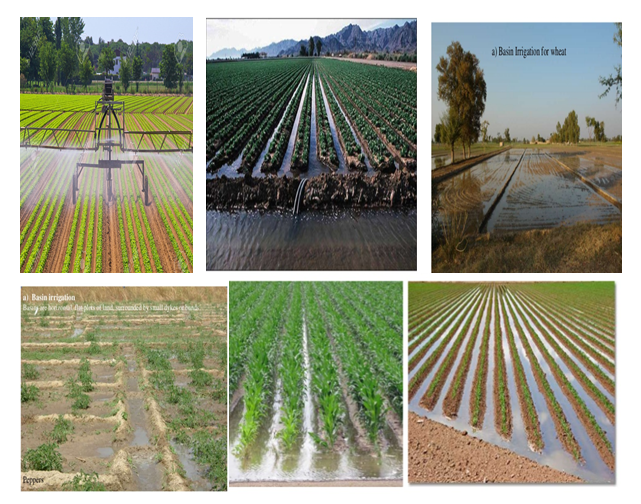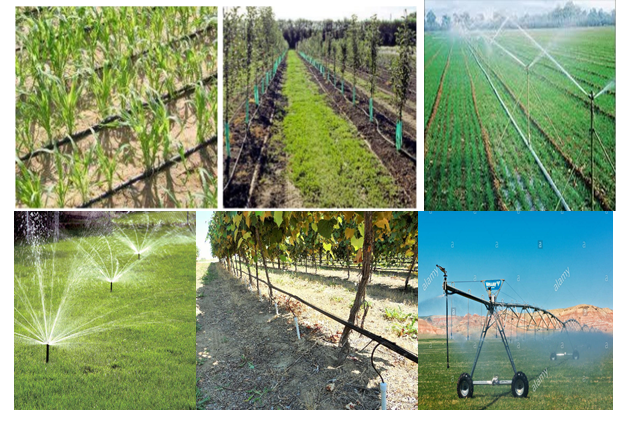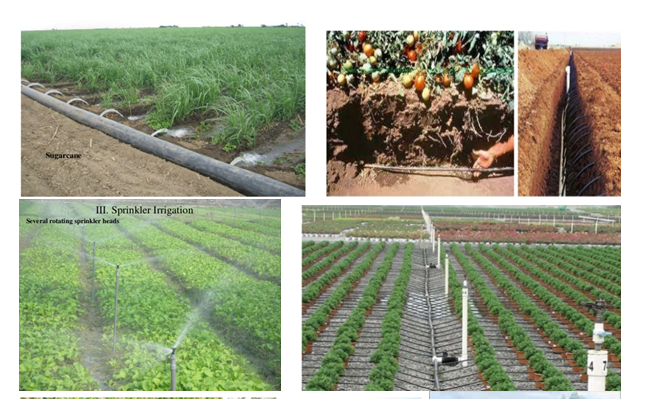Back to: AGRICULTURAL SCIENCE SS2
Welcome to Class !!
We are eager to have you join us !!
In today’s Agricultural Science class, We will be learning about Irrigation and Farm Drainage. We hope you enjoy the class!
IRRIGATION AND DRAINAGE
CONTENT
- Meaning
- Types
- Advantages and Disadvantages
IRRIGATION
This is the artificial application of water to soil or land for farming purposes.
FACTORS THAT DETERMINES IRRIGATION SYSTEM
- Availability of water.
- The slope of the land.
- Soil type.
- Type of crop.
- Size of the farmland.
IMPORTANCE OF IRRIGATION IN CROP PRODUCTION
- Irrigation softens the soil for tillage operations.
- It provides moisture in the soil for root absorption.
- It reduces the amount of salt accumulated in the topsoil which could be injurious to the crops.
- It cools the soil, thereby reducing soil, theory reducing soil temperature.
- It enables crops to do well.
- It increases crop productivity and yields.
- It assists in the production of crops all-round the year.
- It helps in microbial decomposition and nutrient release to the soil.
- It dissolves soil nutrient for root absorption.
NEGATIVE EFFECTS OF IRRIGATION
- It provides a humid environment which favours the buildup of pests and diseases.
- It encourages the spread of weeds seeds.
EVALUATION
- What is irrigation?
- List two negative effects of irrigation.
TYPES OF IRRIGATION SYSTEMS
The three types of irrigation systems are:
- Surface irrigation
- Sub-surface irrigation
- Overhead irrigation
SURFACE IRRIGATION
In this system, water from rivers, dams or stream flows along the surface of the land to the farmland. This can be in the form of channels, flooding, contour ditch, furrow, basin etc. This type of irrigation requires a gentle slope to be successful.
ADVANTAGES OF SURFACE IRRIGATION
- It removes excess water caused by heavy rainfall.
- It is easier to establish or setup.
- It is cheap to maintain.
- It prevents the accumulation of alkali.
- It increases activities of microbes in the too soil.
DISADVANTAGES OF SURFACE IRRIGATION
- It cannot be practised where land is hilly.
- It cannot be successful in sandy soil.
- The volume of water, especially in flooding may be difficult to control.
- Some crops may not tolerate heavy flooding.

SUBSURFACE IRRIGATION
In this system, water is applied below the soil surface. It involves the use of perforated pipes to deliver the water within the soil. This water gets to the root through capillary action.
ADVANTAGES OF SUBSURFACE IRRIGATION
- It is possible to maintain water at optimum depth for crop need.
- Water used efficiently.
- It ensures low evaporation loses from the soil.
- It does not create obstruction when carrying out cultural practices.
DISADVANTAGES OF SUBSURFACE IRRIGATION
- Water with high salt content cannot be used.
- It requires some level of expertise or technical know-how.
- It is a bit expensive.

OVERHEAD IRRIGATION
In this system, water is supplied to the farmland above the surface of the soil.
PROBLEMS ASSOCIATED WITH OVERHEAD IRRIGATION
- Wind can cause an uneven distribution of water by distorting sprinkler pattern.
- The spray force can damage the ripening of soft fruits.
- Stable water supply is needed for economic use of the equipment.
- The initial investment is usually high.
- Power requirement for pumping water is high.
- Requires technical-know-how.
- It can spread diseases.
- Laterals pipes hinder the movement of farm machines.
- The high cost of maintenance, repair and spare parts.
There are two types of overhead irrigation:
- Drip irrigation
- Sprinkler irrigation
SPRINKLER IRRIGATION
In this system, water is sprayed from the air and allowed to fall on the ground like rain through a nozzle under pressure.
ADVANTAGES OF SPRINKLER IRRIGATION
- The amount of water supplied is regulated.
- It economizes the use of water.
- It is suitable for arid lands with high evapotranspiration rate.
- It can be used for all crops except for tree crops.
- Soluble fertilizers and herbicides can be applied through the irrigation water.
DISADVANTAGES OF SPRINKLER IRRIGATION
- Sprinkler irrigation is costly to operate.
- High wind velocity may prevent the distribution of water.
- Stable water supply is required.
- It requires high power to produce the high pressure needed to pump water into pipes.
- There is a lack of sufficient technical know-how on sprinkle irrigation.

DRIP IRRIGATION
Drip irrigation is a method whereby water is discharged through nozzles called emitters or drippers at a selected spacing to deliver water to the soil surface near the base of the plant.
ADVANTAGES OF DRIP IRRIGATION
- It is economical in the use of water.
- It reduces salt concentration in the root zone.
- Fertilizers can be applied through the system.
- It operates with slower and arid areas.
DISADVANTAGES OF DRIP IRRIGATION
- It is very expensive to set up and maintain.
- Water cannot be distributed in sloppy farmland evenly.
- Water with high salt content can be used.
EVALUATION
- Describe surface and sub-surface irrigation.
- Discuss the two types of overhead irrigation.
PROBLEMS ASSOCIATED WITH IRRIGATION
- Inadequate water supply for irrigation.
- Irrigation equipment is expansive.
- Pests from surrounding may invade irrigated areas and damage crops.
- Disease-causing organism increase with increased humidity.
- Vectors e.g. Snails and tsetse flies breed freely in irrigation areas.
- Lack of technical-know-how.
- Excessive dissolution of salt affects crops.
- It disturbs free movement of farm machinery.
HOW TO REDUCE DISEASE SPREAD IN IRRIGATION FARM
- Use of disease-resistant varieties.
- Crop rotation.
- Use of appropriate chemicals.
- Use of clean tools.
- Use of clean or healthy planting materials.
- Destruction of infected crops to prevent the spread of diseases.
- Avoidance of excessive irrigation.
- Weed control.
EVALUATION
- List five problems associated with irrigation.
- List four things that can be done to reduce disease build-up in irrigation farmland.
DRAINAGE
Drainage is the process whereby excess water in the soil is removed artificially to promote good farming activities.
IMPORTANCE OR EFFECTS OF DRAINAGE
- It helps in regaining waterlogged soil for crop production.
- It improves soil structure and water holding capacity of the soil.
- It improves soil aeration for good root respiration.
- It gives a suitable condition for the growth of microbes which helps in decomposition.
- It helps to increase soil temperature.
- Drainage leaches excess salt from the soil which prevents poisoning and death of the plants.
- It makes tillage operation easier.
- It reduces the incidence of crop diseases.
- It enhances the harvest of crops e.g swamp rice.
- It enhances the early planting of crops.
- It makes land preparation easier.
- It reduces soil acidity.
- It increases soil temperature.
- It increases crop production.
- It makes soil workable soil and light.
- It reduces soil salinity.
TYPES OF DRAINAGE
- Surface drainage
- Sub-surface drainage
SURFACE DRAINAGE
This involves the orderly removal of excess water artificially from the surface of the land using constructed open ditches, field drains and land grading.
ADVANTAGES OF SURFACE DRAINAGE
- It is relatively easy to construct.
- It is cheaper than the subsurface drainage system.
DISADVANTAGES OF SURFACE DRAINAGE
- It occupies good land (space) that could have been used for planting.
- It hinders the passage of machines like tractor.
- It is prone to gully erosion.
- It requires frequent maintenance.
- It increases the cost of production.
- Farm mechanization is impaired.
- It is expensive and difficult to establish.
SUBSURFACE DRAINAGE
This is the orderly removal of excess water from the land using tiles or moles or perforated pipes dug under the ground, it is also called underground drainage.
ADVANTAGES OF SURFACE DRAINAGE
- It does not pose any threat to machines.
- High values of crops are grown.
- It leaves the field free from surface obstruction.
- More land is made available for cultivation.
- Cost of maintenance is low.
- Drainage is faster and more efficient.
DISADVANTAGES OF SUBSURFACE DRAINAGE
- It is very expensive to operate.
- It cannot easily be constructed.
- It is difficult to maintain.
- It needs a very deep excavation of the soil.

READING ASSIGNMENT
Essential Agricultural Science for Senior Secondary Schools by O.A. Iwena, Chapter 19, pages 204 – 208
SECTION B
- (a) Define the term irrigation?
(b) Discuss six problems associated with irrigation.
- State and explain the two systems of drainage.
We have come to the end of this class. We do hope you enjoyed the class?
Should you have any further question, feel free to ask in the comment section below and trust us to respond as soon as possible.
In our next class, we will be learning about Environmental factors affecting Agricultural Practices. We are very much eager to meet you there.

Very impressive
Nice one
keep it up
This blog post on irrigation and drainage systems is both informative and well-structured! It does an excellent job covering the various types of irrigation, explaining how each system works, and the contexts where each is most effective. The breakdown of drainage types was particularly helpful, as it highlighted not just the benefits but also the potential limitations of each system. This level of detail is great for students and anyone interested in understanding the basics of agriculture and land management.
Given that drainage is essential to maintain soil quality and prevent crop damage, I wonder if there could be additional insights on drainage considerations specific to properties with septic systems. Proper septic drainage management is crucial, especially where irrigation and drainage systems overlap in agricultural settings. Could you expand on how these systems can work together effectively without compromising the septic system or soil health?